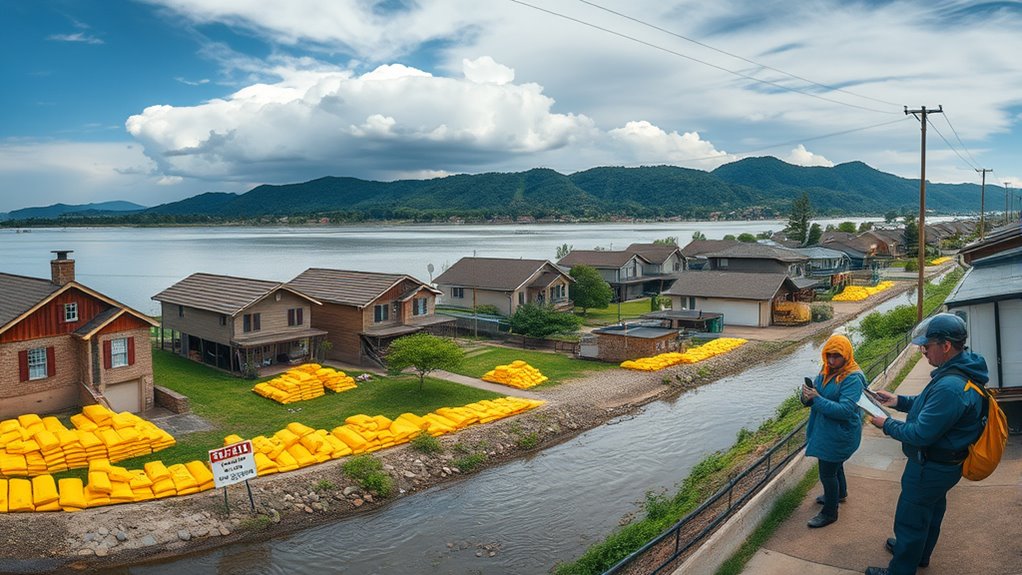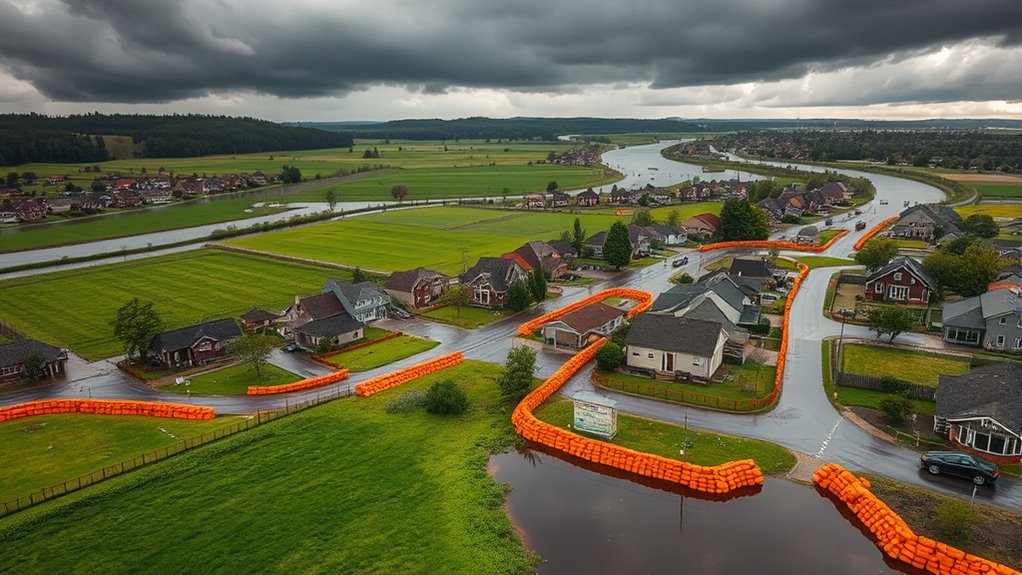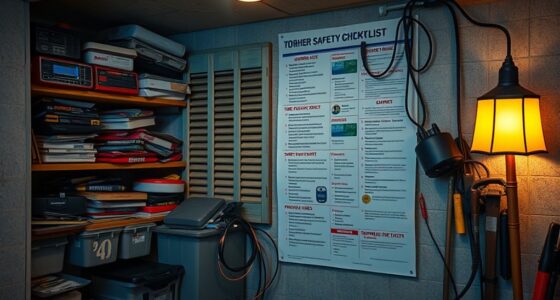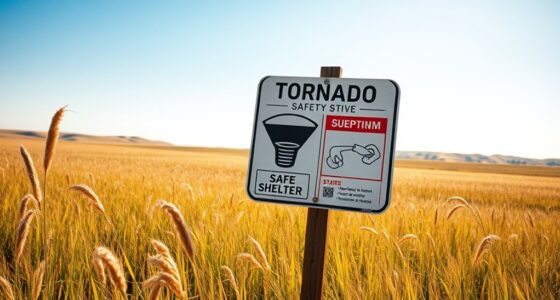To prepare for regional flooding, familiarize yourself with local evacuation plans and safe routes, and check designated zones with authorities. Secure flood insurance and review your coverage regularly, especially before flood season. Assemble an emergency kit with essentials like water, food, medications, and important documents, kept in an accessible spot. Stay informed via alerts and set up a communication plan with family. Implement property safeguards like elevating electrical systems and installing barriers. Continuing your efforts will guarantee you’re ready for any flood event.
Key Takeaways
- Familiarize yourself with local evacuation plans, routes, and designated zones to ensure swift action during floods.
- Purchase and regularly review flood insurance coverage specific to flood-prone areas.
- Prepare an emergency kit with essentials like water, food, medications, documents, and pet supplies for quick evacuation.
- Stay informed through community alerts, weather updates, and maintain a communication plan with family and neighbors.
- Implement property safeguards such as elevating electrical systems and installing flood barriers; continuously update flood preparedness strategies.

Are you prepared for the possibility of flooding in your region? Flooding can strike unexpectedly, and being ready means having a clear plan of action. One of the most important steps you can take is to familiarize yourself with evacuation plans specific to your area. These plans outline the safest routes to leave your home quickly and efficiently, helping you avoid dangerous floodwaters and traffic congestion. Check with local authorities or community agencies to understand the designated evacuation zones and routes before a flood threatens your neighborhood. Having this knowledge in advance reduces panic and confusion during an emergency, guaranteeing you can evacuate swiftly when necessary.
In addition to knowing your evacuation plans, securing flood insurance is a key safeguard. Standard homeowners’ policies typically don’t cover flood damage, so investing in flood insurance protects your property and belongings against potential financial devastation. It’s wise to review your coverage regularly and understand what is included and excluded. If you live in a flood-prone area, purchasing flood insurance should be a top priority. It provides peace of mind, knowing that when floodwaters rise, your financial burden won’t be overwhelming. Remember, flood insurance policies often take time to activate—typically 30 days—so it’s critical to get coverage well before flood season begins.
Preparing an emergency kit is another essential step. Pack essentials like bottled water, non-perishable food, medications, important documents, and clothing. Keep this kit in a readily accessible location, so you can grab it quickly if you need to evacuate. Don’t forget to include supplies for pets and a flashlight with extra batteries. Having everything prepared in advance ensures you’re ready to leave immediately if authorities issue an evacuation order. Additionally, utilizing keto diet tracking apps can help you maintain your health and energy levels during stressful times, ensuring you stay physically prepared for emergencies.
Staying informed is equally important. Sign up for local alerts and weather updates through community alert systems or mobile apps. These notifications will keep you aware of developing risks and any evacuation orders. It’s also helpful to establish a communication plan with family members and neighbors, so everyone knows how to stay in touch during a flood event.
Finally, consider safeguarding your property by elevating electrical systems and installing flood barriers if feasible. These measures can greatly reduce damage and make cleanup easier afterward. Remember, flood preparedness isn’t a one-time effort—it’s an ongoing process that requires attention and updates. By understanding your evacuation plans, securing flood insurance, and staying informed, you’ll be better equipped to protect yourself, your loved ones, and your property against the unpredictable threat of floods.
Frequently Asked Questions
How Often Should I Review My Flood Emergency Plan?
You should review your flood emergency plan at least once a year to make certain it’s current. Conduct regular drills every six months to practice your response, making any necessary adjustments. After significant weather events or changes in your circumstances, update your plan immediately. Staying proactive helps you stay prepared, identify gaps, and feel confident when a flood threat occurs. Consistent review and drills keep your readiness sharp and effective.
Are There Financial Aid Programs for Flood Damage Recovery?
Yes, you can access financial aid programs like flood damage grants and disaster recovery funds to help recover from flood damage. These programs provide essential support for repairs, temporary housing, and other recovery needs. To qualify, you typically need to register with FEMA or local agencies promptly after a flood. Keep documentation of damages prepared and stay informed about available assistance through official channels to guarantee you receive the aid you’re entitled to.
What Are the Signs of Upcoming Flooding in My Area?
When floodwaters loom like a warning siren, you’ll notice rising water levels, darkening skies, and strong storm surges. A levee breach may create sudden flooding, and increased water flow signals trouble ahead. Keep an eye on weather alerts and local reports. By recognizing these signs early, you can prepare and protect your home before floodwaters arrive, turning awareness into action and keeping you safe.
How Can I Protect My Pets During a Flood?
To safeguard your pets during a flood, prioritize pet safety by making certain they have a collar with ID tags and are microchipped. Prepare emergency supplies like food, water, medications, and comfort items in a waterproof container. Keep your pets indoors as much as possible and have a plan to quickly evacuate with them if needed. Regularly practice your evacuation plan to stay calm and ensure everyone’s safety during the emergency.
Are Flood Insurance Policies Mandatory in Flood-Prone Regions?
Think of flood insurance requirements as your safety net in a flood zone. While not always mandatory, if you’re in a high-risk flood zone, flood zone mapping often makes it a necessity to have insurance. Many lenders require it before approving a mortgage, ensuring you’re protected when waters rise. So, check your area’s flood zone status and understand the insurance requirements to stay prepared and secure.
Conclusion
Now, imagine the streets turning into rushing rivers and the sky darkening with looming storms. By staying informed and prepared, you can navigate these waters safely, keeping yourself and loved ones secure amid the rising tide. Remember, your readiness acts as a sturdy boat against the flood’s chaos. When you’re prepared, you won’t just survive the storm—you’ll face it with confidence, knowing you’ve done everything to protect what matters most.









